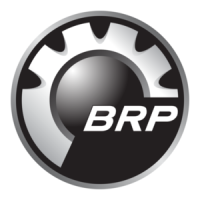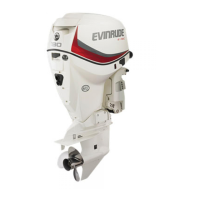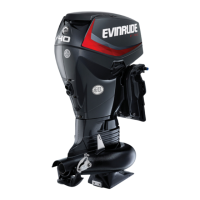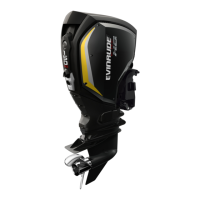Do you have a question about the BRP EVINRUDE E-TEC 200 and is the answer not in the manual?
Provides critical safety information before working on the outboard, including hazard symbols and signal words.
Lists and defines common abbreviations used throughout the manual for units of measurement and technical terms.
Details federal laws and responsibilities regarding emissions for installation, maintenance, and repair.
Explains the structure and meaning of model numbers, including style, horsepower, length, and year.
Lists the specific Evinrude E-TEC V-model outboards covered by this service manual.
Provides detailed technical specifications for engine, fuel, electrical, cooling, ignition, gearcase, and trim/tilt systems.
Lists standard torque values for various fastener sizes when specific torques are not provided elsewhere.
Explains that illustrations may not depict actual models and are for representative views only.
Provides a chart of recommended inspections and maintenance tasks based on usage and time intervals.
Details the correct procedure and fixtures for safely lifting the outboard motor.
Explains practices for connecting control cables, hoses, and wiring for rigging the outboard.
Outlines procedures for adjusting various systems, including tilt limit switches and trim sending units.
Details essential checks for the engine monitoring system, fuel system, and start-in-gear prevention.
Describes the components and checks for the cooling system, including water intake screens and flushing procedures.
Covers lubrication points for steering, throttle, shift linkage, and gearcase using specified lubricants.
Covers inspection and maintenance of fuel filters, oil systems, air silencers, and hoses for proper operation.
Explains methods for protecting metal components and exterior finishes from corrosion.
Provides procedures for preparing the outboard for storage, including fuel system treatment and software control.
Outlines essential checks and services needed before preparing the outboard for seasonal use.
Details the critical procedures for servicing outboards that have been submerged in water.
Covers procedures for servicing the upper engine cover, including latch hook and cap replacement.
Details the removal, installation, and servicing of the lower engine cover and its components.
Provides an overview of the EMM's role as an engine controller and its functions.
Lists the various processes and functions controlled by the EMM, from alternator output to sensor monitoring.
Details the importance of clean and tight electrical connections for the EMM and its associated wiring.
Describes internal sensors monitored by the EMM, including temperature, voltage, and pressure sensors.
Details external sensors monitored by the EMM, such as air temperature, engine temperature, and oil pressure sensors.
Explains how to use Evinrude Diagnostics software to access and interpret EMM data, tests, and information.
Covers the procedures for removing and installing the EMM, including data transfer and essential maintenance.
Outlines methods for diagnosing system issues through visual, software, and operational inspections.
Provides systematic steps for diagnosing and resolving common outboard problems like no crank or no start.
Explains diagnostic tests performed while the engine is running, such as cylinder drop tests and fuel control adjustments.
Details the meaning of EMM LED indicators during key on, starting, and running states for quick diagnosis.
Covers tests for ignition system components, including coils, capacitors, and wiring, to ensure proper spark output.
Outlines procedures for testing the fuel system, including static and running tests for pumps and injectors.
Provides a visual overview of electrical and ignition components with torque specifications.
Illustrates the complete ignition system wiring, showing connections between key components.
Details the pinouts and wire colors for EMM and stator connectors, essential for harness servicing.
Emphasizes the importance of clean and tight ground connections for reliable electrical system performance.
Provides procedures for testing various sensors, including CPS, TPS, engine temperature, and air temperature sensors.
Covers resistance and voltage output tests for the stator to diagnose charging system issues.
Outlines tests for the 12V and 55V charging circuits, including battery requirements and alternator output.
Details the start circuit diagram, solenoid wiring, and tests for proper starter operation.
Covers testing procedures for key switches and neutral start circuits to ensure proper operation.
Explains how to test SystemCheck warning lights, horn, and related circuits for proper alert function.
Provides a visual exploded view of fuel system components and their related specifications for fuel system.
Illustrates the correct routing of fuel hoses for both 3.3 L and 3.4 L models.
Shows the electrical and fuel flow schematic for the entire fuel system, including injectors and EMM.
Details regulations, portable fuel tank guidelines, and fuel flow/quality requirements.
Describes key fuel system components like the lift pump, fuel filter, vapor separator, and fuel injectors.
Provides step-by-step instructions for priming the fuel system, including vent line clamp and primer bulb usage.
Covers essential tests for the fuel system, including pressure tests for pumps, regulators, and injectors.
Provides a visual overview of oiling system components and their related specifications.
Illustrates the routing of oil supply lines for both 3.3 L and 3.4 L models.
Shows the routing of oil recirculation hoses and fittings for proper crankcase oil management.
Details recommended lubricants, engine lubricant usage at low temperatures, and oil tank assembly.
Lists and describes the main components of the oiling system, including the oil tank, injection pump, and sensors.
Explains how to set oil injection rates based on oil type, applications, and includes powerhead break-in procedures.
Provides detailed instructions for priming the oil system, including hose, pump, and cylinder priming.
Covers various tests for the oiling system, including static and voltage tests for injection pumps and resistance tests.
Illustrates the water flow path and hose routing for the 3.3 L cooling system.
Illustrates the water flow path and hose routing for the 3.4 L cooling system.
Describes key cooling system components like water pumps, intakes, adapter housings, and thermostats.
Explains the two-stage cooling system design and how water flow is controlled by thermostats and valves.
Details procedures for checking engine operating temperatures using software or a pyrometer.
Covers the removal, inspection, and assembly of thermostats to ensure proper cooling system operation.
Provides instructions for disassembling, inspecting, and assembling the pressure relief valve.
Provides an exploded view of ICON remote control components and their related specifications.
Lists and describes the main components of the ICON remote control system, including ESM, shift, and throttle actuators.
Covers servicing procedures for the Electronic Servo Module (ESM), including removal and installation.
Details the removal and installation procedures for the shift actuator, including important notes on calibration.
Outlines the removal and installation procedures for the throttle actuator, emphasizing calibration.
Explains how to set engine identity and calibrate actuators for optimal ICON system performance.
Provides a chart to identify and diagnose ICON system faults based on LED indicators and fault codes.
Provides an exploded view of powerhead components and their related specifications.
Details the procedure for testing cylinder compression to diagnose internal engine health.
Outlines the steps for safely removing the powerhead from the outboard for servicing.
Covers the systematic removal of various components from the powerhead for disassembly.
Explains how to clean cylinder block and combustion chambers, removing carbon deposits and preparing for assembly.
Details procedures for inspecting internal components like cylinder heads, crankshafts, pistons, and rings for wear or damage.
Provides instructions for assembling internal powerhead components, including bearings, crankshaft, and pistons.
Covers the procedure for installing the powerhead onto the exhaust housing, including torque specifications and alignment.
Lists essential adjustments and procedures to perform before returning a serviced or rebuilt powerhead to operation.
Provides visual references of hose routings from different angles for 3.3 L and 3.4 L models.
Provides a visual exploded view of stern bracket components and their related specifications.
Covers the disassembly and assembly of the stern bracket, including removal of anodes and swivel bracket.
Details the disassembly, cleaning, inspection, and assembly of the exhaust housing for 3.3 L models.
Details the disassembly, cleaning, inspection, and assembly of the exhaust housing for 3.4 L models.
Covers the removal and installation of the tilt tube, including necessary tools and procedures.
Provides procedures for removing and servicing the exhaust housing, including lower mount checks.
Outlines the steps for disassembling the stern bracket, including removing trim/tilt units and steering components.
Details the procedure for assembling the stern bracket, including installing rollers, supports, and bushings.
Provides an exploded view of gearcase components and their related specifications for V6 models.
Explains the identification of "L2" and "M2" type gearcases and their housing profiles.
Covers propeller inspection, selection based on performance, and hardware installation procedures.
Details the procedure for testing the gearcase for leaks using pressure and vacuum testers.
Provides instructions for safely removing and reinstalling the gearcase assembly, including shift rod adjustment.
Covers the disassembly, inspection, and assembly of the water pump for proper cooling system function.
Explains how to check and adjust shift rod height for proper gear engagement and NEUTRAL detent.
Outlines the steps for disassembling standard rotation gearcases, including inspection of housing and shafts.
Details the procedures for assembling the gearcase, including driveshaft shimming and shift housing installation.
Covers specific disassembly and assembly procedures for counter-rotation gearcases.
Provides an exploded view of trim and tilt components and their related specifications.
Explains the power trim/tilt hydraulic system components and their functions.
Describes the hydraulic system's operation in Trim-OUT/Tilt-UP and Tilt-DOWN/Trim-IN modes.
Explains how the impact relief system protects the outboard from underwater impacts.
Details the tilt relief mechanism used in shallow water drive modes to prevent over-pressurization.
Explains how the thermal expansion relief system handles fluid expansion due to temperature changes.
Describes the procedure for manually positioning the outboard by opening the manual release valve.
Outlines essential routine checks for the trim/tilt system, including fluid levels, manual release valve, and stern brackets.
Provides a systematic approach to diagnosing and resolving trim/tilt system malfunctions using symptoms and tests.
Details how to manually lower or trim the outboard by opening the manual release valve.
Covers electrical tests for relays, motor current draw, and trim gauges to diagnose system faults.
Provides detailed procedures for removing and installing the trim and tilt unit.
Covers disassembly and assembly procedures for tilt pistons, trim rods, and related components.
Discusses safety for boat users, emphasizing proper rigging, maintenance, and part substitution.
Highlights critical aspects of outboard shift systems and how to minimize risks associated with loss of shift control.
Focuses on the importance of the speed control system and minimizing risks related to loss of speed control.
Addresses steering system safety, potential hazards from component failure, and maintenance practices.
Covers safety precautions related to fuel and electrical systems, emphasizing fire and explosion prevention.
Provides guidance on safely handling outboards, particularly during lifting and mounting procedures.
Warns about hazards when operating the engine with the cover removed, focusing on moving parts and electrical safety.
Explains potential dangers of incorrect starting procedures, emphasizing safety checks before starting.
Provides a systematic guide to diagnose and resolve issues preventing the outboard from starting.
Lists possible causes and procedures for diagnosing outboards that start but run poorly.
Details troubleshooting for scenarios where the outboard fails to shut off when the key switch or stop circuit is grounded.
Outlines possible causes and procedures for diagnosing outboards that start and run but then stall.
Addresses issues related to low maximum RPM and excessive smoking, linking them to potential causes and checks.
Provides troubleshooting steps for erratic engine operation, surges, and rough running conditions.
Provides critical safety information before working on the outboard, including hazard symbols and signal words.
Lists and defines common abbreviations used throughout the manual for units of measurement and technical terms.
Details federal laws and responsibilities regarding emissions for installation, maintenance, and repair.
Explains the structure and meaning of model numbers, including style, horsepower, length, and year.
Lists the specific Evinrude E-TEC V-model outboards covered by this service manual.
Provides detailed technical specifications for engine, fuel, electrical, cooling, ignition, gearcase, and trim/tilt systems.
Lists standard torque values for various fastener sizes when specific torques are not provided elsewhere.
Explains that illustrations may not depict actual models and are for representative views only.
Provides a chart of recommended inspections and maintenance tasks based on usage and time intervals.
Details the correct procedure and fixtures for safely lifting the outboard motor.
Explains practices for connecting control cables, hoses, and wiring for rigging the outboard.
Outlines procedures for adjusting various systems, including tilt limit switches and trim sending units.
Details essential checks for the engine monitoring system, fuel system, and start-in-gear prevention.
Describes the components and checks for the cooling system, including water intake screens and flushing procedures.
Covers lubrication points for steering, throttle, shift linkage, and gearcase using specified lubricants.
Covers inspection and maintenance of fuel filters, oil systems, air silencers, and hoses for proper operation.
Explains methods for protecting metal components and exterior finishes from corrosion.
Provides procedures for preparing the outboard for storage, including fuel system treatment and software control.
Outlines essential checks and services needed before preparing the outboard for seasonal use.
Details the critical procedures for servicing outboards that have been submerged in water.
Covers procedures for servicing the upper engine cover, including latch hook and cap replacement.
Details the removal, installation, and servicing of the lower engine cover and its components.
Provides an overview of the EMM's role as an engine controller and its functions.
Lists the various processes and functions controlled by the EMM, from alternator output to sensor monitoring.
Details the importance of clean and tight electrical connections for the EMM and its associated wiring.
Describes internal sensors monitored by the EMM, including temperature, voltage, and pressure sensors.
Details external sensors monitored by the EMM, such as air temperature, engine temperature, and oil pressure sensors.
Explains how to use Evinrude Diagnostics software to access and interpret EMM data, tests, and information.
Covers the procedures for removing and installing the EMM, including data transfer and essential maintenance.
Outlines methods for diagnosing system issues through visual, software, and operational inspections.
Provides systematic steps for diagnosing and resolving common outboard problems like no crank or no start.
Explains diagnostic tests performed while the engine is running, such as cylinder drop tests and fuel control adjustments.
Details the meaning of EMM LED indicators during key on, starting, and running states for quick diagnosis.
Covers tests for ignition system components, including coils, capacitors, and wiring, to ensure proper spark output.
Outlines procedures for testing the fuel system, including static and running tests for pumps and injectors.
Provides a visual overview of electrical and ignition components with torque specifications.
Illustrates the complete ignition system wiring, showing connections between key components.
Details the pinouts and wire colors for EMM and stator connectors, essential for harness servicing.
Emphasizes the importance of clean and tight ground connections for reliable electrical system performance.
Provides procedures for testing various sensors, including CPS, TPS, engine temperature, and air temperature sensors.
Covers resistance and voltage output tests for the stator to diagnose charging system issues.
Outlines tests for the 12V and 55V charging circuits, including battery requirements and alternator output.
Details the start circuit diagram, solenoid wiring, and tests for proper starter operation.
Covers testing procedures for key switches and neutral start circuits to ensure proper operation.
Explains how to test SystemCheck warning lights, horn, and related circuits for proper alert function.
Provides a visual exploded view of fuel system components and their related specifications for fuel system.
Illustrates the correct routing of fuel hoses for both 3.3 L and 3.4 L models.
Shows the electrical and fuel flow schematic for the entire fuel system, including injectors and EMM.
Details regulations, portable fuel tank guidelines, and fuel flow/quality requirements.
Describes key fuel system components like the lift pump, fuel filter, vapor separator, and fuel injectors.
Provides step-by-step instructions for priming the fuel system, including vent line clamp and primer bulb usage.
Covers essential tests for the fuel system, including pressure tests for pumps, regulators, and injectors.
Provides a visual overview of oiling system components and their related specifications.
Illustrates the routing of oil supply lines for both 3.3 L and 3.4 L models.
Shows the routing of oil recirculation hoses and fittings for proper crankcase oil management.
Details recommended lubricants, engine lubricant usage at low temperatures, and oil tank assembly.
Lists and describes the main components of the oiling system, including the oil tank, injection pump, and sensors.
Explains how to set oil injection rates based on oil type, applications, and includes powerhead break-in procedures.
Provides detailed instructions for priming the oil system, including hose, pump, and cylinder priming.
Covers various tests for the oiling system, including static and voltage tests for injection pumps and resistance tests.
Illustrates the water flow path and hose routing for the 3.3 L cooling system.
Illustrates the water flow path and hose routing for the 3.4 L cooling system.
Describes key cooling system components like water pumps, intakes, adapter housings, and thermostats.
Explains the two-stage cooling system design and how water flow is controlled by thermostats and valves.
Details procedures for checking engine operating temperatures using software or a pyrometer.
Covers the removal, inspection, and assembly of thermostats to ensure proper cooling system operation.
Provides instructions for disassembling, inspecting, and assembling the pressure relief valve.
Provides an exploded view of ICON remote control components and their related specifications.
Lists and describes the main components of the ICON remote control system, including ESM, shift, and throttle actuators.
Covers servicing procedures for the Electronic Servo Module (ESM), including removal and installation.
Details the removal and installation procedures for the shift actuator, including important notes on calibration.
Outlines the removal and installation procedures for the throttle actuator, emphasizing calibration.
Explains how to set engine identity and calibrate actuators for optimal ICON system performance.
Provides a chart to identify and diagnose ICON system faults based on LED indicators and fault codes.
Provides an exploded view of powerhead components and their related specifications.
Details the procedure for testing cylinder compression to diagnose internal engine health.
Outlines the steps for safely removing the powerhead from the outboard for servicing.
Covers the systematic removal of various components from the powerhead for disassembly.
Explains how to clean cylinder block and combustion chambers, removing carbon deposits and preparing for assembly.
Details procedures for inspecting internal components like cylinder heads, crankshafts, pistons, and rings for wear or damage.
Provides instructions for assembling internal powerhead components, including bearings, crankshaft, and pistons.
Covers the procedure for installing the powerhead onto the exhaust housing, including torque specifications and alignment.
Lists essential adjustments and procedures to perform before returning a serviced or rebuilt powerhead to operation.
Provides visual references of hose routings from different angles for 3.3 L and 3.4 L models.
Provides a visual exploded view of stern bracket components and their related specifications.
Covers the disassembly and assembly of the stern bracket, including removal of anodes and swivel bracket.
Details the disassembly, cleaning, inspection, and assembly of the exhaust housing for 3.3 L models.
Details the disassembly, cleaning, inspection, and assembly of the exhaust housing for 3.4 L models.
Covers the removal and installation of the tilt tube, including necessary tools and procedures.
Provides procedures for removing and servicing the exhaust housing, including lower mount checks.
Outlines the steps for disassembling the stern bracket, including removing trim/tilt units and steering components.
Details the procedure for assembling the stern bracket, including installing rollers, supports, and bushings.
Provides an exploded view of gearcase components and their related specifications for V6 models.
Explains the identification of "L2" and "M2" type gearcases and their housing profiles.
Covers propeller inspection, selection based on performance, and hardware installation procedures.
Details the procedure for testing the gearcase for leaks using pressure and vacuum testers.
Provides instructions for safely removing and reinstalling the gearcase assembly, including shift rod adjustment.
Covers the disassembly, inspection, and assembly of the water pump for proper cooling system function.
Explains how to check and adjust shift rod height for proper gear engagement and NEUTRAL detent.
Outlines the steps for disassembling standard rotation gearcases, including inspection of housing and shafts.
Details the procedures for assembling the gearcase, including driveshaft shimming and shift housing installation.
Covers specific disassembly and assembly procedures for counter-rotation gearcases.
Provides an exploded view of trim and tilt components and their related specifications.
Explains the power trim/tilt hydraulic system components and their functions.
Describes the hydraulic system's operation in Trim-OUT/Tilt-UP and Tilt-DOWN/Trim-IN modes.
Explains how the impact relief system protects the outboard from underwater impacts.
Details the tilt relief mechanism used in shallow water drive modes to prevent over-pressurization.
Explains how the thermal expansion relief system handles fluid expansion due to temperature changes.
Describes the procedure for manually positioning the outboard by opening the manual release valve.
Outlines essential routine checks for the trim/tilt system, including fluid levels, manual release valve, and stern brackets.
Provides a systematic approach to diagnosing and resolving trim/tilt system malfunctions using symptoms and tests.
Details how to manually lower or trim the outboard by opening the manual release valve.
Covers electrical tests for relays, motor current draw, and trim gauges to diagnose system faults.
Provides detailed procedures for removing and installing the trim and tilt unit.
Covers disassembly and assembly procedures for tilt pistons, trim rods, and related components.
Discusses safety for boat users, emphasizing proper rigging, maintenance, and part substitution.
Highlights critical aspects of outboard shift systems and how to minimize risks associated with loss of shift control.
Focuses on the importance of the speed control system and minimizing risks related to loss of speed control.
Addresses steering system safety, potential hazards from component failure, and maintenance practices.
Covers safety precautions related to fuel and electrical systems, emphasizing fire and explosion prevention.
Provides guidance on safely handling outboards, particularly during lifting and mounting procedures.
Warns about hazards when operating the engine with the cover removed, focusing on moving parts and electrical safety.
Explains potential dangers of incorrect starting procedures, emphasizing safety checks before starting.
Provides a systematic guide to diagnose and resolve issues preventing the outboard from starting.
Lists possible causes and procedures for diagnosing outboards that start but run poorly.
Details troubleshooting for scenarios where the outboard fails to shut off when the key switch or stop circuit is grounded.
Outlines possible causes and procedures for diagnosing outboards that start and run but then stall.
Addresses issues related to low maximum RPM and excessive smoking, linking them to potential causes and checks.
Provides troubleshooting steps for erratic engine operation, surges, and rough running conditions.
| Starting | Electric |
|---|---|
| Full Throttle RPM Range | 5000-6000 RPM |
| Horsepower | 200 hp (149 kW) |
| Fuel Type | Gasoline |
| Cooling System | Water-cooled |
| Ignition System | Electronic |
| Fuel System | Direct Fuel Injection |
| Fuel Induction System | Direct Injection |
| Alternator Output | 50 Amp |
| Exhaust | Through Propeller |
| Shaft Length | 20" or 25" |











